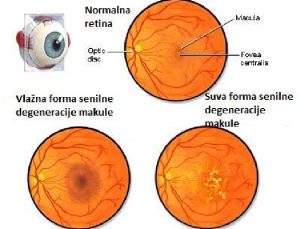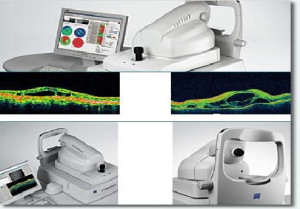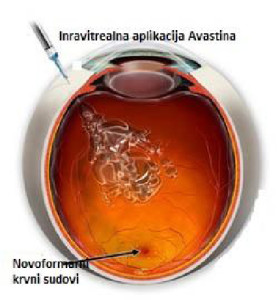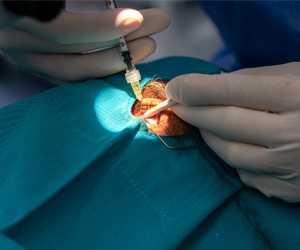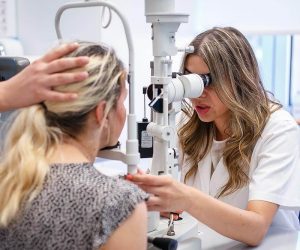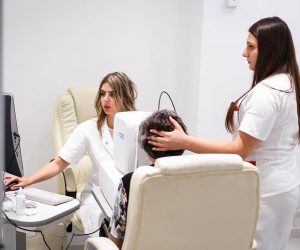Age-Related Macular Degeneration is the leading cause of blindness in developed countries and one of the leading ophthalmic problems of modern ophthalmology. The risk of this disease increases significantly with age. In the population aged between 65 to 75, it is found in 10%, while in the population over 75 the risk is in 35%.
Age-Related Macular Degeneration is a disease that affects the “point of focus” in the human eye – macula, or part of the retina responsible for central vision and distinction of details. The macula consists of photoreceptors (rods and cones), the cells that are highly specialized to receive a light stimulus, turning it into a nerve impulse that is transmitted to the centers in the brain, where their analysis is performed and the image of the observed object is formed. Their dense arrangement in the macula enables the sharpness of vision, detail and character recognition, reading, writing, recognition of colors.
Age-related macular degeneration (AMD) does not cause total blindness, however, it causes deterioration in the quality of life by blurred vision and failures in the central part of the visual field. Macular degeneration develops gradually and painlessly. Eyesight can be impaired in one eye more than in the other, and also sight in the other eye can be preserved much longer. In this case, it is harder to notice the change, because good vision in one eye compensates for the defects of the diseased eye. Problems with vision and quality of life arise when changes affect both eyes (e.g. when the person is watching the clock, the hands are seen blurred while hour numbers are recognized clearly).
The age: the risk of acquiring this disease increases with aging.
Obesity: obese patients with macular degeneration have twice the risk of developing severe forms of macular degeneration compared to those with normal weight.
Insufficient physical activity: moderate physical activity, practiced at least three times a week, reduces the risk of disease progression.
Genetic Factor: genetic predisposition is certainly an important factor in developing the disease. Most recent studies have shown that the specific embodiments of different genes are present in the majority of patients who suffer from age-related macular degeneration, and the hereditary factor has an important role in its development.
Smoking: Smoking is an important risk factor for age-related macular degeneration, both active and passive smoking. British Journal of Ophthalmology 2006 published a study according to which people living with smokers are subject to doubles risk of macular degeneration.
The dry form of Age-Related Macular Degeneration – is caused by the damage to the retinal pigment epithelium and photoreceptor loss, which leads to a gradual loss of central vision. It is far more common than the wet form, affecting approximately 90% of patients with macular degeneration. It is believed that this is a milder form of the disease, but there is a risk that may turn dry macula into the wet form of age-related macular degeneration.
The wet form of Age-Related Macular Degeneration – is a more difficult form of this disease, more detrimental for the vision. It is characterized by the proliferation of abnormal blood vessels due to the rupture and destruction of the pigment layer of the retina. These newly generated blood vessels (choroidal neovascularization or CNV) were of poor quality, increased permeability, and consequently, there is a discharge of liquids and blood below the retina. This form of the disease ends in destruction and atrophy of the retinal tissue with scarring in the macula, leading to a drastic reduction in visual acuity in patients.
Early detection of changes is of crucial importance in age-Related Macular Degeneration. The first step in diagnosis is a detailed eye examination, including an examination of the fundus. Performing the test with the Amsler grid is further one of the ways to examine the function of the macula. Optical coherence tomography (OCT) is the gold standard diagnosis, which enables a topographical way of presenting all layers of the retina and precise detection of pathological changes. In addition to determining the first diagnosis by OCT, it plays an important role in the monitoring of the therapeutic effects.
The therapeutic approach depends on the type and stage of the disease. Currently, there is no specific therapy in the case of the dry form of Age-Related Macular Degeneration. Taking high doses of antioxidants and zinc may slow down the disease progression.
The research was conducted which showed that daily consumption of 500 mg vitamin C, 400 IU (international units) of vitamin E, 15 mg beta carotene, 80 mg of zinc, and 2 mg of copper lowers the risk of disease progression by 25%. Consuming food rich in antioxidants (vitamin A, E, C, zinc, beta carotene), consumption of fish (a diet rich in omega 3 fatty acids), smoking cessation, good control and treatment of other systemic diseases, as well as regular visits to an ophthalmologist, can significantly reduce the risk of progression of the disease and preserve vision.
Treatment of wet form of Age-Related Macular Degeneration requires a more aggressive therapeutic approach that involves the concomitant application of Anti-VEGF therapy (Avastin / Lucentis) directly into the vitreous body of the eye of the patient.
Any defect in the deeper layers of the retina occurs as a result of the vascular endothelial growth factor (VEGF) release, which leads to the formation of new blood vessels further to bleeding, scarring, and the formation of a significant drop in sight. Avastin is an antibody to VEGF, which after injection into the eye binds to VEGF, blocking its action and preventing the formation of new blood vessels as well as the partial withdrawal of already formed blood vessels.
In cases where there are indications for the use of anti-VEGF therapy, a number of injections should be given to put the disease under control, and one can never tell in advance how many injections are required and whether the disease will recur after the last application of the medicine.
What can be expected from the application of injections of Avastin?
- The application is performed under local anesthesia in sterile conditions of the operating room
- The intervention is neither painful nor uncomfortable, the patient receiving the injection can soon go home with a bandage on the treated eye carried up to tomorrow’s follow-up
- After the intervention, in-home care conditions, the dripping of antibiotic drops is included in order to prevent possible infection.
- Depending on the treatment length and the stage of the disease, after the application of injections, a number of patients can expect an improvement in visual acuity, while in some patients slowdown or stoppage in the further course of the disease can be expected.
- A small number of patients may fall under the “non-responder” group who can expect further deterioration of visual acuity in the diseased eye, but definitely not as much as it would have happened without the use of any therapy.


